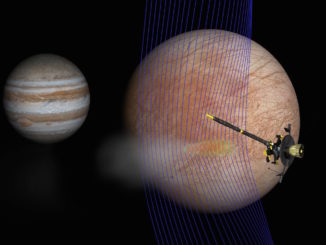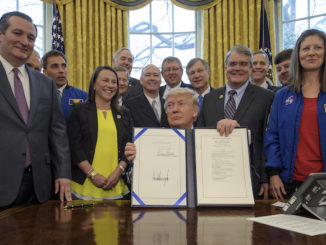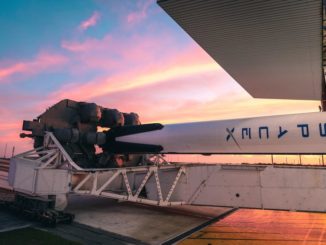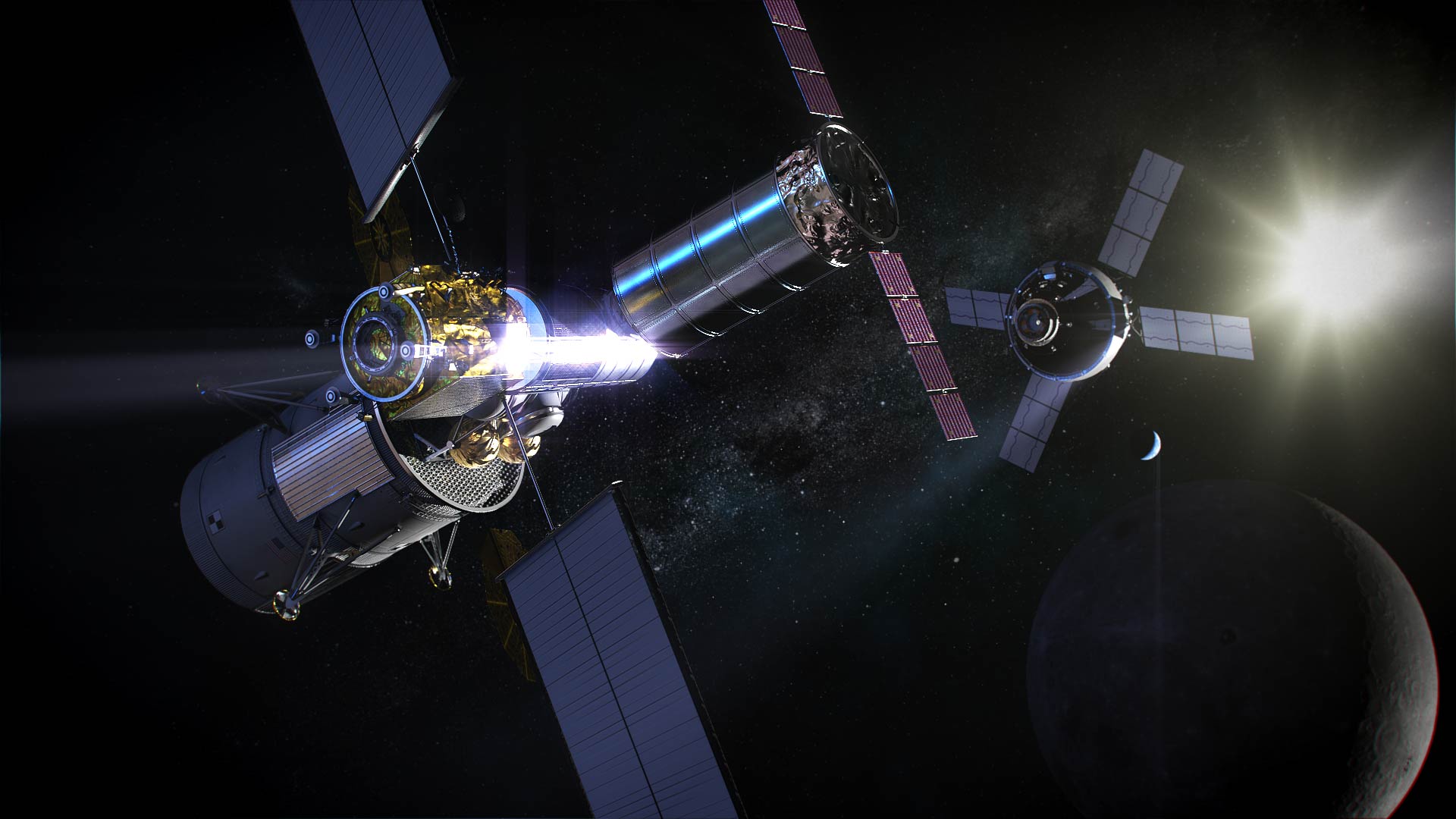
Racing against the clock to meet the Trump administration’s 2024 deadline to land astronauts on the moon, NASA plans to select Northrop Grumman to build a pressurized habitation module derived from the company’s Cygnus cargo craft for living quarters for crews transiting to and from the lunar surface.
The Northrop Grumman habitation module could be ready for launch in December 2023, and other companies under consideration for the work could not demonstrate they would be ready to launch a habitat into deep space in time for a 2024 lunar landing mission under NASA’s Artemis program.
NASA is also bypassing a traditional procurement process for the Minimal Habitation Module. Rather than requesting bids from industry, and then evaluating the responses, NASA plans to fast-track a contract with Northrop Grumman Innovation Systems, an operating unit of Northrop Grumman formerly known as Orbital ATK.
The pressurized habitation compartment will be docked with the Gateway’s Power and Propulsion Element in a stable near-rectilinear halo orbit around the moon. NASA announced in May that Maxar Technologies won a contract worth up to $375 million to build the Power and Propulsion Element, which will provide electricity and maneuvering capability for the Gateway station using high-power plasma thrusters, but does not include any pressurized section.
The Gateway is a mini-space station NASA plans to build in an orbit that swings as close as 2,000 miles from the moon about once per week. The Gateway will act as a stopover and safe haven for astronauts heading for the moon’s surface.
NASA is designing the mini-station to accommodate myriad scientific experiments and engineering demonstrations required for more ambitious ventures deeper into the solar system, and eventually Mars.
NASA originally planned to build out the Gateway with a larger habitation module, a refueling and logistics depot, science labs, and a Canadian-built robotic arm before attempting a human landing on the moon around 2028.
Vice President Mike Pence changed that plan with a speech in March at NASA’s Marshall Space Flight Center in Alabama. Pence declared NASA should land astronauts on the moon before the end of 2024 “by any means necessary,” prompting Gateway managers to shuffle their plans and focus on constructing a more operating base in lunar orbit within the next five years.
NASA still plans to add more elements to the Gateway, including contributions from international partners, after accomplishing the human landing on the moon.
NASA has worked with Bigelow Aerospace, Boeing, Lockheed Martin, Northrop Grumman Innovation Systems, Sierra Nevada Corp. and NanoRacks to develop ground prototypes and concepts for deep space habitats since 2016. The Next Space Technologies for Exploration Partnerships-2 (NextSTEP-2), Appendix A, agreements included habitation module prototypes at NASA centers in Alabama, Florida and Texas, and at Bigelow Aerospace’s facility in North Las Vegas, Nevada.
NASA concluded the other companies’ habitat proposals would be not ready in time for a launch before the end of 2023.
The cost of the Minimal Habitation Module was redacted from the sole-source justification document, and a NASA spokesperson said final value of the contract will hinge on negotiations between Northrop Grumman and NASA.
“NASA and Northrop Grumman will be negotiating a contract value in the coming months,” said Rachel Kraft, a NASA spokesperson. “Selecting them now allows Northrop Grumman to procure some long-lead items before we finalize a contract value.”
The space agency outlined officials’ rationale for selecting Northrop Grumman in lieu of a full and open competition in a contracting document.
“In order to meet the Gateway program’s schedule and support the vice president’s 2024 human lunar landing mandate, NASA determined it was necessary to continue to work with NGIS (Northrop Grumman Innovation Systems) for these highly specialized services,” NASA wrote in a justification document. “NGIS was the only NextSTEP-2 contractor with a module design and the production and tooling resources capable of meeting the 2024 deadline.”
Northrop Grumman has launched 12 Cygnus missions to resupply the International Space Station, and another is set for launch in October. The Cygnus spacecraft itself has a perfect record, but one mission was lost on a launch failure.
“After an assessment of current design work already underway, the agency decided in May to procure one or more modules for the Gateway from the American companies which already developed concepts for deep space habitats as part of the agency’s NextSTEP-2 initiative,” Kraft said in a statement. “NASA now has determined that Northrop Grumman Innovation Systems is best suited to meet the agency’s timeline for building and launching the first habitation module for the Gateway because it plans to leverage its extensive production capabilities and design maturity from its Cygnus cargo spacecraft to meet NASA’s goals and timeline for a 2024 moon landing.”
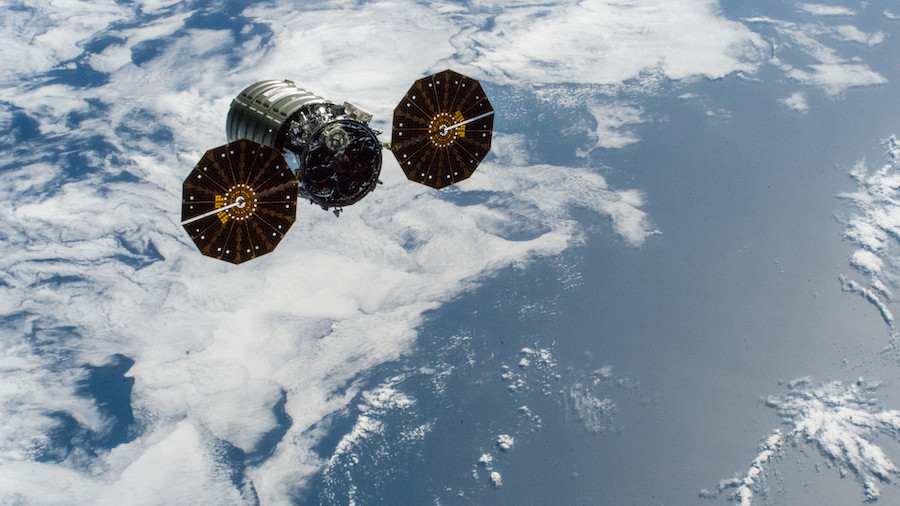
NASA said arranging a full and open competition would take 12-to-18 months, time the space agency can ill afford if it aims to land astronauts on the moon in five years.
In order to support a December 2023 launch, the Minimal Habitation Module must arrive at the Kennedy Space Center in Florida to begin launch preparations in mid-2023, NASA said.
According to the sole-source justification document, NASA has spent $87 million to date on the NextSTEP habitation module studies.
In selecting Northrop Grumman to develop the Minimal Habitation Module, NASA officials wrote that “no other NextSTEP-2 provider has … existing capabilities which, when considered collectively, provide the only viable approach to successfully achieving the 2024 lunar mandate.”
NASA cited Northrop Grumman’s existing Cygnus production line, in which Cygnus service modules are manufactured at Northrop Grumman’s headquarters in Dulles, Virginia, and pressurized cargo modules come from Thales Alenia Space in Turin, Italy.
Northrop Grumman has also advanced design and development for adaptations to the existing Cygnus spacecraft that will be used at the Gateway, such as body-mounted radiators and radial docking ports to accommodate visiting crew and cargo vehicles, and future permanent additions to the Gateway complex.
“NGIS is the only NextSTEP-2 contractor uniquely able to complete design, development and production of the MHM (Minimal Habitation Module) within the time necessary to launch in late 2023 and get the module on station in lunar orbit early 2024 using existing launch vehicles,” NASA wrote in the sole-source justification document.
“NGIS has an existing, active pressurized module manufacturing capability via their ongoing Cygnus module construction subcontractor that has provided experience and lessons learned from development of 13 Cygnus vehicles to date, refining management and technical interactions and interchanges,” NASA wrote.
Northrop Grumman has an exclusive contracting agreement with Thales for pressurized cargo modules. The Cygnus cargo compartment is based on the Multi-Purpose Logistics Modules built by Thales to launch inside the payload bay of the space shuttle packed with several tons of supplies and experiments for the International Space Station.
Thales Alenia Space also manufactured several permanent modules on the International Space Station.
“This existing contractual relationship (between Northrop Grumman and Thales Alenia Space) and its associated production pedigree are critical to timely development progress and problem resolution, which are substantive mitigations to schedule risk,” NASA wrote.
According to NASA’s sole-source justification document, the Gateway’s Minimal Habitation Module use a pressurized module with the same 10-foot (3.07-meter) diameter as the Cygnus cargo compartment, allowing the spacecraft to fit inside the payload fairing envelope of existing commercial rockets.
Cygnus resupply missions to the space station have launched on Northrop Grumman’s own Antares booster, and aboard United Launch Alliance’s Atlas 5 rocket.
“Additionally, the smaller diameter of the NGIS module enables other externally mounted capabilities, including batteries, communication antennae, and payloads to be incorporated upon launch and available for the initial mission,” NASA wrote. “These capabilities uniquely establish a minimum risk development posture for supplying the initial docking and habitable transfer capability necessary to support lunar operations in 2024.”
In an interview with Spaceflight Now earlier this year, a senior Northrop Grumman official discussed the company’s plans for a deep space habitat.
“Going out to cislunar space will be a little bit different,” said Frank DeMauro, vice president and general manager of Northrop Grumman’s space systems division. “So we’ve looked at the avionics upgrades required for the higher radiation environment, different communications systems, docking versus berthing systems.
“We think we’re in a good place to offer NASA a proven, yet upgraded technology suite on a Cygnus-class vehicle to provide all sorts of services out in cislunar space, whether it’s habitats, logistics services, science and utilization services, as well as even power and propulsion systems out there. Cygnus is a stepping stone from that point of view,” DeMauro said.
Meanwhile, NASA has kicked off procurement steps to select a commercial provider for a human-rated lunar lander that launch on a commercial rocket and dock with the Gateway, where astronauts arriving on an Orion spacecraft — lifted into space by NASA’s Space Launch System heavy-duty rocket — will transfer to the descent craft for the trip to the moon’s surface.
NASA hopes to select a company to oversee development of the human-rated moon lander by the end of the year.
Email the author.
Follow Stephen Clark on Twitter: @StephenClark1.

